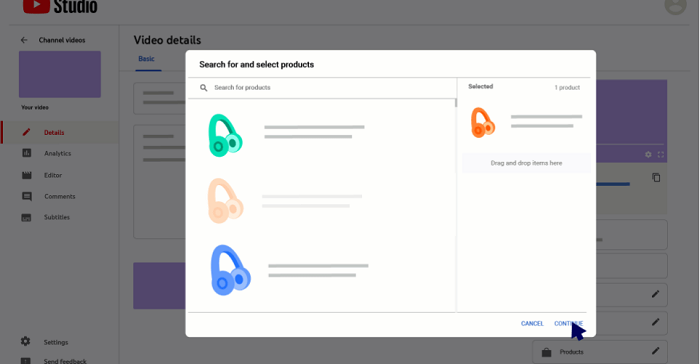Social Media, Web Development
YouTube Expands Test of Product Tagging in Uploads, Providing Another Creator Monetization Option
- By Brett Belau
20 Jul

With all the major platforms now looking to integrate commerce options, YouTube’s expanding its test of third-party product tags, which enable chosen creators to tag products that are featured in their video clips, with the creator, at least at present, being paid by directly by YouTube for using these item highlights.
As you can see in this example, some creators are being prompted to tag products as shoppable items, without having to establish separate branded content deals for such.
“Viewers will be able to learn more about the products, and discover ways to purchase them without leaving YouTube.”
As reported by Business Insider, YouTube launched the first iteration of the program back in April, but more recently, it’s been inviting more creators into the fold. Over time, that’s expanding the amount of product tags within clips, which will help to raise awareness of the option, while it could also help to shift user behaviors around the process, and eventually, provide another pathway for monetization in the app.
It’s similar to Instagram’s product tagging process, which it also launched back in April, enabling creators to earn a commission from any direct sales generated as a result of their products tags.

Though as noted, YouTube’s system, at least right now, is not based on commission per sale, with YouTube instead playing a flat, monthly rate to creators for using the tool.
As per Business Insider:
“[One] creator was offered a minimum of $50 each month for using the feature, plus they could earn up to $0.08 each time a viewer clicked on a product tag and visited the product page. The cost-per-click rate YouTube is offering varies by creator and product based on a “number of factors,” the company told Insider, but declined to share more on the exact payment structure.”
Eventually, you would expect that YouTube would be looking to move to a direct affiliate program, with creators earning a cut from sales generated, establishing another ecosystem to facilitate monetization in the app, while also helping to expand its eCommerce push.
Though questions remain as to how much users actually want to shop in social apps, and how valuable such tags and in-stream buying options will be.
In-stream shopping has been a transformative trend in China, with some other Asian markets also taking to the more streamlined product display to purchase process. But thus far, western audiences haven’t been as quick to jump onto the trend, despite the overall rise in online shopping behavior.
Live-stream commerce is where most social apps are currently focused, with TikTok, Meta and YouTube all incorporating varying forms of live-stream shopping tools to align with impulsive shopping behaviors and modern engagement trends.
That could still become a thing, but the results thus far show that while consumers are researching products within social apps, they’re generally happy to purchase them on each company’s own website. Which could present a larger challenge here, in that it may reflect a distrust in the payment services offered within social apps, and in registering your bank details in connection with your in-app data.
I mean, when you consider the bad press around data sharing and privacy that’s been attached to Meta and TikTok in particular, that wouldn’t be surprising, while Chinese regulators have far more control over how such businesses operate in their region. That could be a key challenge for western platforms to overcome – or maybe, this is just a generational shift, and as younger consumers grow up, and have more spending capacity, in-stream shopping will become a more accepted, adopted behavior.
Either way, the jury’s currently out on the process, but what you can be sure of is that whatever one platform launches, the others will follow, as they all seek to offer the best revenue share deals for creators, in order to better align them to their apps.
If in-stream shopping catches on, TikTok could see big success with product tags and its Shop tools, as it has already in China, which is why Meta and YouTube have little choice but to offer the same, in case that happens, and they miss the boat on a key opportunity.
I don’t see it becoming a big thing right away, but you can expect in-stream buying to gain momentum over time, especially as more people have better, safer experiences in providing their payment details within each app.
Source: www.socialmediatoday.com, originally published on 2022-07-20 21:09:46
Connect with B2 Web Studios
Get B2 news, tips and the latest trends on web, mobile and digital marketing
- Appleton/Green Bay (HQ): (920) 358-0305
- Las Vegas, NV (Satellite): (702) 659-7809
- Email Us: [email protected]

© Copyright 2002 – 2022 B2 Web Studios, a division of B2 Computing LLC. All rights reserved. All logos trademarks of their respective owners. Privacy Policy

![How to Successfully Use Social Media: A Small Business Guide for Beginners [Infographic]](https://b2webstudios.com/storage/2023/02/How-to-Successfully-Use-Social-Media-A-Small-Business-Guide-85x70.jpg)



![How to Successfully Use Social Media: A Small Business Guide for Beginners [Infographic]](https://b2webstudios.com/storage/2023/02/How-to-Successfully-Use-Social-Media-A-Small-Business-Guide-300x169.jpg)


Recent Comments